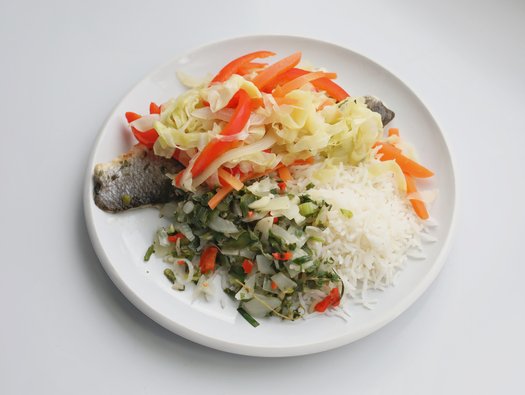Escovitch fish

A high protein dish with a lovely homemade green seasoning that provides lots of flavour with no added salt.

A high protein dish with a lovely homemade green seasoning that provides lots of flavour with no added salt.
2 medium size fish fillets eg bass, haddock, salmon or red mullet/snapper (up to 100g each)
1 lime or lemon
120g uncooked rice
½ small green cabbage, shredded
1 carrot, thinly sliced
½ red pepper, sliced
½ onion, chopped
10ml red or white wine vinegar
1 tablespoon of oil
2 heaped teaspoons fresh thyme
2 heaped teaspoons fresh chives
2 heaped teaspoons fresh coriander
2 cloves garlic, chopped
½ onion, chopped
1 small scotch bonnet, chopped (optional)
2 spring onions, chopped
Place the fish in a large bowl and squeeze the lemon over it, turning the fish to ensure the lemon juice covers both sides.
Add the green seasoning marinade ingredients to the fish and combine using your hands. Set aside for 10 minutes for the flavours to infuse. If you have had a kidney transplant, take extra food safety precautions and marinade your fish in the fridge, not at room temperature.
Heat a saucepan of water on the hob and boil the cabbage, carrot, pepper and onion for 5 minutes. Drain and return to the pan; mix in the vinegar. Cook the rice as per packet instructions (avoid adding salt).
While the rice is cooking, place a non-stick frying pan over a low to medium heat, add the oil. Remove the fish from the seasoning marinade (reserving it for later) and cook for 2-3 minutes on each side until cooked through.
Once the fish is cooked, remove it from the pan and set it aside, keeping it warm. Using the same frying pan, cook the reserved green seasoning marinade over a low to medium heat, until the onion has softened, around 3-5 minutes.
Serve the fish with a portion of rice, the vegetable mixture and the cooked green seasoning.
The rice is the main source of carbohydrate in this dish and the values have been provided for those who have trained in insulin adjustment.
Although this dish does contain some potassium, overall, when keeping to the portion sizes suggested, this dish is low in potassium and can be enjoyed as part of a low potassium diet.
This dish is low in phosphate, however it does contain some phosphate, mainly provided by the fish. If you have been prescribed a phosphate binder ensure you take them with this dish.
This recipe is high in protein, provided by the fish, which makes it suitable for anyone receiving dialysis.
You could increase the fibre in this dish by using a wholegrain variety of rice.
Look for special offers on red fish and use herbs that have been frozen to avoid waste.
This dish is best eaten fresh.
If you have had a transplant you should buy your fish pre-packaged, rather than from a fresh fish counter, in order to avoid any risk of bacterial contamination.
By giving us your email address, you're giving us permission to send you the latest news from Kidney Care UK. Further information about how we protect and use your personal data is available in our Privacy policy. If you would like to change the way we communicate with you at any time please email [email protected]. You can unsubscribe at any time by using the link at the bottom of every email we send.